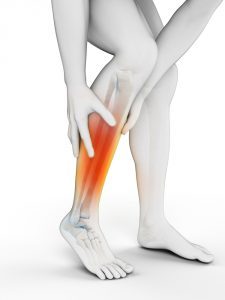 Netball is the most popular female sport in Australia, with women and children alike participating in the high-intensity, fast-paced game. But with every dodge, intercept or ‘break’, comes the potential for injury. As the netball season intensifies and the expectations at training, game days and carnivals rise, we see a myriad of foot and leg problems; with the most common being shin splints.
Netball is the most popular female sport in Australia, with women and children alike participating in the high-intensity, fast-paced game. But with every dodge, intercept or ‘break’, comes the potential for injury. As the netball season intensifies and the expectations at training, game days and carnivals rise, we see a myriad of foot and leg problems; with the most common being shin splints.
The injury is extremely common for netballers, due to the many bursts of rapid acceleration, sudden and swift changes in direction throughout the game, and the hard surfaces of the courts.

How to tell if you’re experiencing shin splints:
- Painful along front and inside bottom half of lower leg
- Painful to touch
- Exercising increases pain
- Stretching increases pain
- Pain reduces once you have warmed up, but returns once you have cooled down
If your pain continues from the start of a game to the finish, this can represent a more severe case of shin splints, or possible compartment syndrome. It is recommended to seek professional diagnosis in any case.
What are shin splints?
Also known as Medial Tibial Stress Syndrome (MTSS), the term ‘shin splints’ is colloquially used to describe pain from a few inches above the ankle, to halfway up the shin bone. Pain can be present on any part of the lower leg, and is caused by the tibial bone having small ‘crack-like’ stress fractures along the point of muscle insertions.
While generally diagnosed as an ‘overuse’ injury, players are at a higher risk when exposed to certain biomechanical and anatomical risk factors, as this causes the tibia to undergo excessive stress. Some examples include:
- Tight calf and hamstring muscles
- Undiagnosed limb length differences
- Excessive foot pronation (rolling in at the heel or arches)
Due to the complexity associated with diagnosing shin splints, and the many different causes and underlying risk factors, getting a professional diagnosis from a podiatrist is key to a quick and full recovery. A podiatrist will assess your lower limbs and feet to determine why you are experiencing shin splints.
Following the completion of a biomechanical assessment, gait analysis and foot scan, our podiatrists can correctly diagnose whether you are suffering from shin splints or another condition. The will then determine the best course of treatment and provide you with a rehabilitation program.
How we can help:
At Podiatry Care, our podiatrists can quickly and effectively identify and treat your case of shin splints. Treatment and management once diagnosed may include:
- Correct and effective stretching plan
- Proper footwear advice
- Advice on training programs for preventing reoccurrence
- Custom-made orthotics
If this sounds like you, your child or teammate player, book an appointment with one of our podiatrists today.


